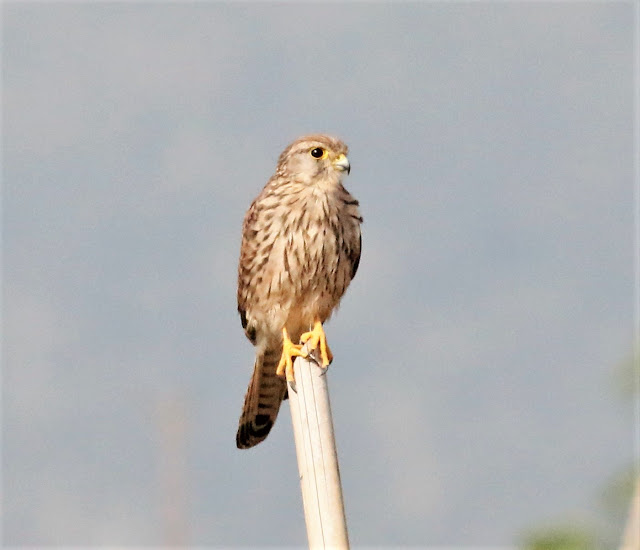It has been widely acknowledged that many scientific data were obtained from the information provided by amateur birders as well as citizen scientist. Bird watching in a non conventional way does not only involve identification of birds. It may also involved observing the type of prey they eat, how they hunt, the interaction between them and their ecosystem etc. When that happens you have actually inadvertently looking at the ecology of things, which is the study of how living things (in this case, birds) interact with their environment/surroundings.
There are not many birders in this region who have the opportunity to observe or let alone photograph the hunting moments of a Common Kestrel (Falco tinnunculus), an Eastern Marsh Harrier (Circus spilonotus) and a Black-Shouldered Kite (Elanus caeruleus), all within one location.
I will start with the Common Kestrel which is a winter visitor in this region.
I was cruising along the dirt track when i spotted a raptor on a perch. Going closer i have identified the raptor as a Common Kestrel (female). Immediately i stopped my car about 50 meters away and tried to take a few photos of this uncommon winter visitor.
At first she look to her right.
Then a bit to her left.
She then took off and flew towards my direction.
Oops ! there is a strange looking human being inside the car. So she decided to change her flight direction.
Like an airplane, she tried to gain some height. Here she is doing just that - gaining as much altitude as possible.
Once she has gained enough height, the hunt begins. RSPB, UK reported that a Common Kestrel can spot a beetle 50m from its perch. Amazing !
Cruising at about 60-70 meters above, the search for prey begins.
Searching diligently for her morning breakfast.
Then i believe she has spotted something on the ground. Wings folded and she is ready to dive.
And then the moment of glory happened. Diving almost 90 degrees with talons all expanded towards her prey.
Holy cow ! she missed the rat by just a few inches.
She did a u-turn in case the rat was still there.
Nope it has gone.
No luck this time and she was back to her perch waiting for another chance.
Next on the hunting list was a male Eastern Marsh Harrier.
Eastern Marsh Harrier hunting style is different. They would prefer to hunt closer to the ground i.e just a few meters above the reeds.
They are just like a big fat Lancaster. Flapping slowly and cruising silently in their hunt for prey.
Their eyes were constantly looking downwards.
I believe he has spotted something on the ground.
Did he got the prey?
Oh dear ! no luck as well. Off he went to look elsewhere.
Now here is the grand old master of stationery flight. This Black-shouldered Kite aka "Helang Tikus" was spotted not too far away from where i stood.
Here is the master demonstrating the famous "hover-hunt style".
I did not pay much attention to it as it did some semi circles and a few dives.
Before i knew it there was already a rat in its talon ! Guess you need to learnt from a local resident on ways to catch a prey in this region.
It was truly an amazing experience to witness all the above spectacular hunting sequence unfolded just right above and in front of me.
HAPPY BIRDING !




































































